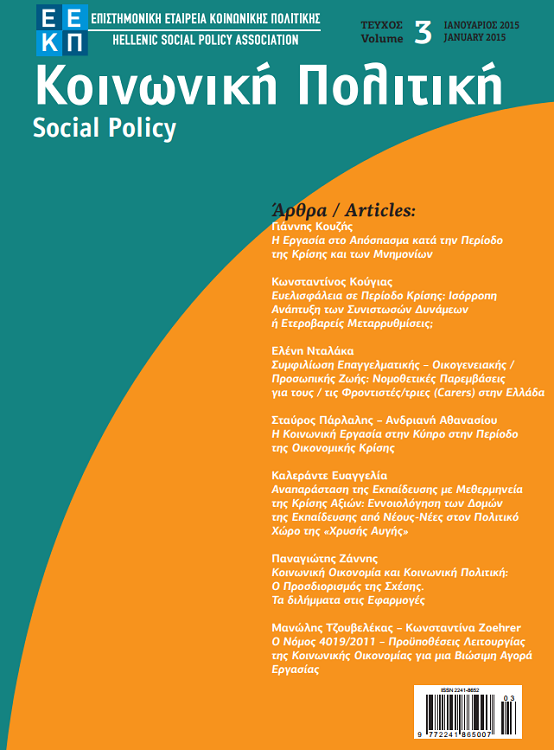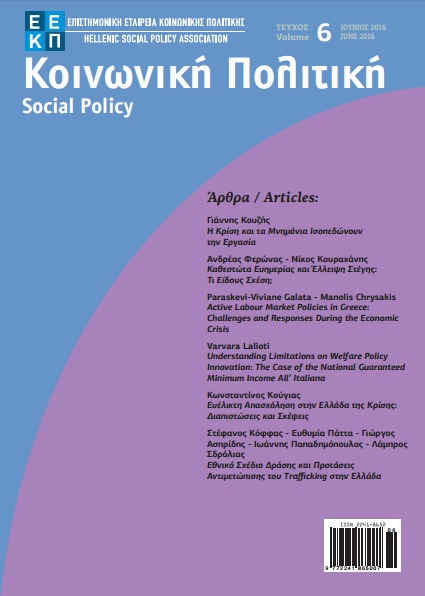Ευελισφάλεια σε Περίοδο Κρίσης: Ισόρροπη Ανάπτυξη των Συνιστωσών Δυνάμεων ή Ετεροβαρείς Μεταρρυθμίσεις;

Περίληψη
Η μελέτη επιχειρεί να διερευνήσει την εφαρμογή της ευελισφάλειας ως εργαλείο πολιτικής της αγοράς εργασίας την περίοδο της κρίσης του 2008 και της συνακόλουθης και παρατεταμένης ύφεσης στην Ευρωπαϊκή Ένωση. Μελετά τις βασικές διαστάσεις της έννοιας της, όπως αυτή αναπτύσσεται στο ενωσιακό θεματολόγιο, εξετάζει τις παρεμβάσεις στις αγορές εργασίας και τις υιοθετούμενες πολιτικές απασχόλησης στη Δανία, τη Γερμανία και την Ελλάδα και ερμηνεύει τα αποτελέσματα προσέγγισης /απόκλισης από τις αρχές της ευελισφάλειας, υπό το φως των ιδιαίτερων συνθηκών των εθνικών αγορών εργασίας και των πολιτικών λιτότητας που αποτελούν κοινό τόπο στον ευρωπαϊκό χώρο.
Λεπτομέρειες άρθρου
- Πώς να δημιουργήσετε Αναφορές
-
Κούγιας Κ. (2017). Ευελισφάλεια σε Περίοδο Κρίσης: Ισόρροπη Ανάπτυξη των Συνιστωσών Δυνάμεων ή Ετεροβαρείς Μεταρρυθμίσεις;. Κοινωνική Πολιτική, 3, 19–48. https://doi.org/10.12681/sp.10588
- Τεύχος
- Τόμ. 3 (2015)
- Ενότητα
- Άρθρα

Αυτή η εργασία είναι αδειοδοτημένη υπό το CC Αναφορά Δημιουργού 4.0.
Οι συγγραφείς των άρθρων που δημοσιεύονται στο περιοδικό διατηρούν τα δικαιώματα πνευματικής ιδιοκτησίας επί των άρθρων τους, δίνοντας στο περιοδικό το δικαίωμα της πρώτης δημοσίευσης. Άρθρα που δημοσιεύονται στο περιοδικό διατίθενται με άδεια Creative Commons 4.0 και σύμφωνα με την άδεια μπορούν να χρησιμοποιούνται ελεύθερα, με αναφορά στο/στη συγγραφέα και στην πρώτη δημοσίευση για μη κερδοσκοπικούς σκοπούς και με δικαίωμα τροποποίησης μόνον με παρόμοια διανομή (αν αναμείξετε, τροποποιήσετε, ή δημιουργήσετε πάνω στο υλικό, πρέπει να διανείμετε τις δικές σας συνεισφορές υπό την ίδια άδεια όπως και το πρωτότυπο).



